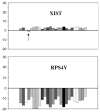Gender-specific gene expression in post-mortem human brain: localization to sex chromosomes
- PMID: 14583743
- PMCID: PMC3130534
- DOI: 10.1038/sj.npp.1300337
Gender-specific gene expression in post-mortem human brain: localization to sex chromosomes
Abstract
Gender differences in brain development and in the prevalence of neuropsychiatric disorders such as depression have been reported. Gender differences in human brain might be related to patterns of gene expression. Microarray technology is one useful method for investigation of gene expression in brain. We investigated gene expression, cell types, and regional expression patterns of differentially expressed sex chromosome genes in brain. We profiled gene expression in male and female dorsolateral prefrontal cortex, anterior cingulate cortex, and cerebellum using the Affymetrix oligonucleotide microarray platform. Differentially expressed genes between males and females on the Y chromosome (DBY, SMCY, UTY, RPS4Y, and USP9Y) and X chromosome (XIST) were confirmed using real-time PCR measurements. In situ hybridization confirmed the differential expression of gender-specific genes and neuronal expression of XIST, RPS4Y, SMCY, and UTY in three brain regions examined. The XIST gene, which silences gene expression on regions of the X chromosome, is expressed in a subset of neurons. Since a subset of neurons express gender-specific genes, neural subpopulations may exhibit a subtle sexual dimorphism at the level of differences in gene regulation and function. The distinctive pattern of neuronal expression of XIST, RPS4Y, SMCY, and UTY and other sex chromosome genes in neuronal subpopulations may possibly contribute to gender differences in prevalence noted for some neuropsychiatric disorders. Studies of the protein expression of these sex-chromosome-linked genes in brain tissue are required to address the functional consequences of the observed gene expression differences.
Figures



References
-
- American Psychiatric Association. Diagnostic and Statistical Manual of Mental Disorders. 4. American Psychiatric Association; Washington, DC: 1994.
-
- Andreasen NC, Flaum M, Swayze V, II, O’Leary DS, Alliger R, Cohen G, et al. Intelligence and brain structure in normal individuals. Am J Psychiatry. 1993;150:130–134. - PubMed
-
- Brockdorff N, Ashworth A, Kay GF, Cooper P, Smith S, McCabe VM, et al. Conservation of position and exclusive expression of mouse Xist from the inactive X chromosome. Nature. 1991;351:329–331. - PubMed
-
- Brown CJ, Hendrich BD, Rupert JL, Lafreniere RG, Xing Y, Lawrence J, et al. The human XIST gene: analysis of a 17 kb inactive X-specific RNA that contains conserved repeats and is highly localized within the nucleus. Cell. 1992;71:527–542. - PubMed
Publication types
MeSH terms
Substances
Grants and funding
LinkOut - more resources
Full Text Sources
Other Literature Sources
Molecular Biology Databases

